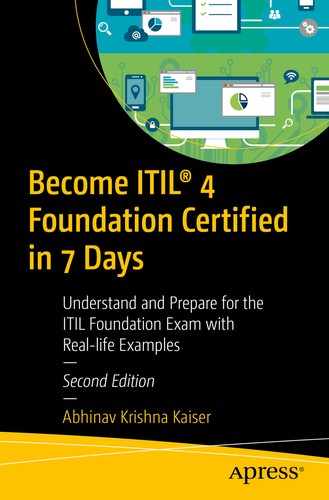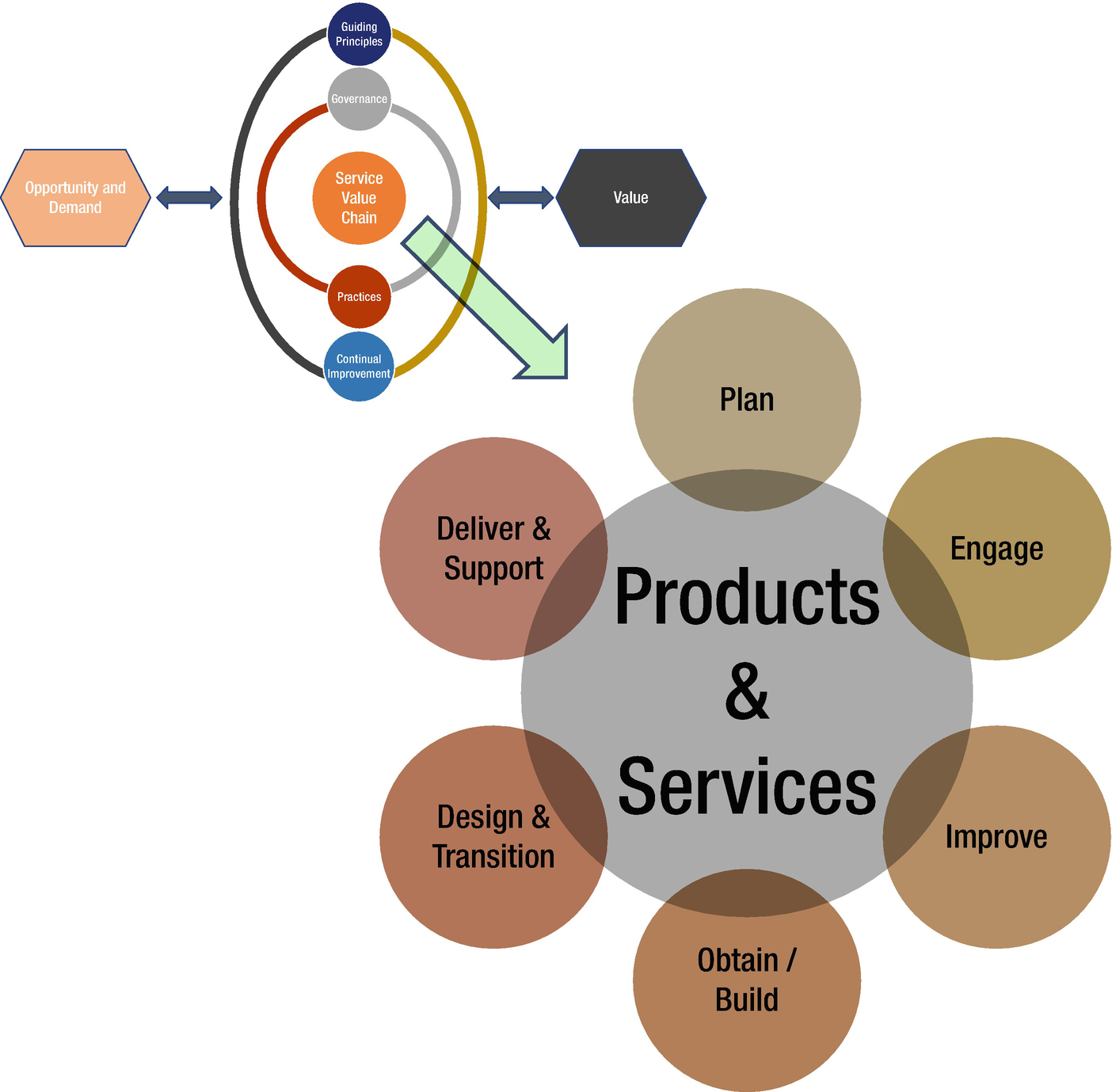ITIL has stood for creating value through services. In ITIL V3, all aspects of service management were seen through the lens of value. It is no different in ITIL 4. In fact, value takes center stage with an entire chapter and multiple concepts revolving around it. What is different is that value is getting the right level of emphasis through a system that is built to deliver it.
This is a chapter focused on the service value system (SVS) and the service value chain (SVC), the engines that bring together and help co-create value. Further, we will explore the guiding principles that were first introduced in the ITIL V3 Practitioner certification course. These concepts are tied together with the concepts of opportunities, demands, and the importance of governance to ensure smooth sailing.
This is an important chapter from the examination standpoint. You can expect to find nine questions from this chapter alone, which can potentially take you through to a third of the marks needed to pass the examination.
Introducing Service Value System
I wrote about the value being co-created between a service provider and a customer. I also mentioned how services can no longer be delivered by a single organization. It needs other organizations, and the service integrates with various services and products to deliver value.
Let’s focus one level deeper. For creating value, an organization, say a service provider organization, needs to have several components and elements to move in harmony to make it happen. For example, the organization would need the power of technology coupled with able people who can architect and build it. To bring these people onboard and others as necessary, you need a hiring function and to take good care of them, a human resources function. Plus, you need the finance departments to pay the salaries among other financial duties. I am just skimming the surface and have identified so many sets of functions that need to work in harmony to deliver value.
Another example that we all can relate to is the working of a car. A car has a zillion parts (or so it seems) and every single one of them is needed for its smooth running. Fuel is needed to power the engine, and the engine converts the fuel energy through combustion into mechanical motion. A battery is required to initiate the engine to start the combustible process. This mechanical motion is fed to the wheels through the mechanism of gears and axles. The wheels themselves need the rubber for a smooth ride and traction. While these are the internal dynamics, you need a controlling mechanism that is managed by a driver who controls the direction of motion using a steering wheel and the power through the combination of a clutch, accelerator, and gearbox. Yes, these are at the simplest level I can explain how a car runs and I am not even getting to the add-ons such as lights, wipers, mirrors, seats, and air conditioning. There are so many other features that modern cars possess that I have no idea where to start and end. My point is that all these parts that I made note of have to work in a particular way for the car to move in the desired direction and speed.
Considering transportation as a service, then the synchronous mechanism of a car that I described is the SVS. It is a system of works that brings together various discrete components into a single homogenous entity that delivers value.
- 1.
Discrete components that work together in unison
- 2.
Organized scheme of things that brings together the discrete components; think of it as the policies, processes, and procedures.
On the topic of a service value system, you can expect to get at least one question (equivalent to one mark) on your ITIL foundation exam. The question will be based on your ability to recall and recognize concepts.
ITIL Definition of Service Value System
The ITIL SVS describes how all the components and activities of the organization work together as a system to enable value creation.
- 1.
Opportunity and Demand as inputs
- 2.
Value as the output
- 3.
Service Value Chain at the center
- 4.
Governance and Practices around it
- 5.
Guiding Principles and Continual Improvement wrapping it all up
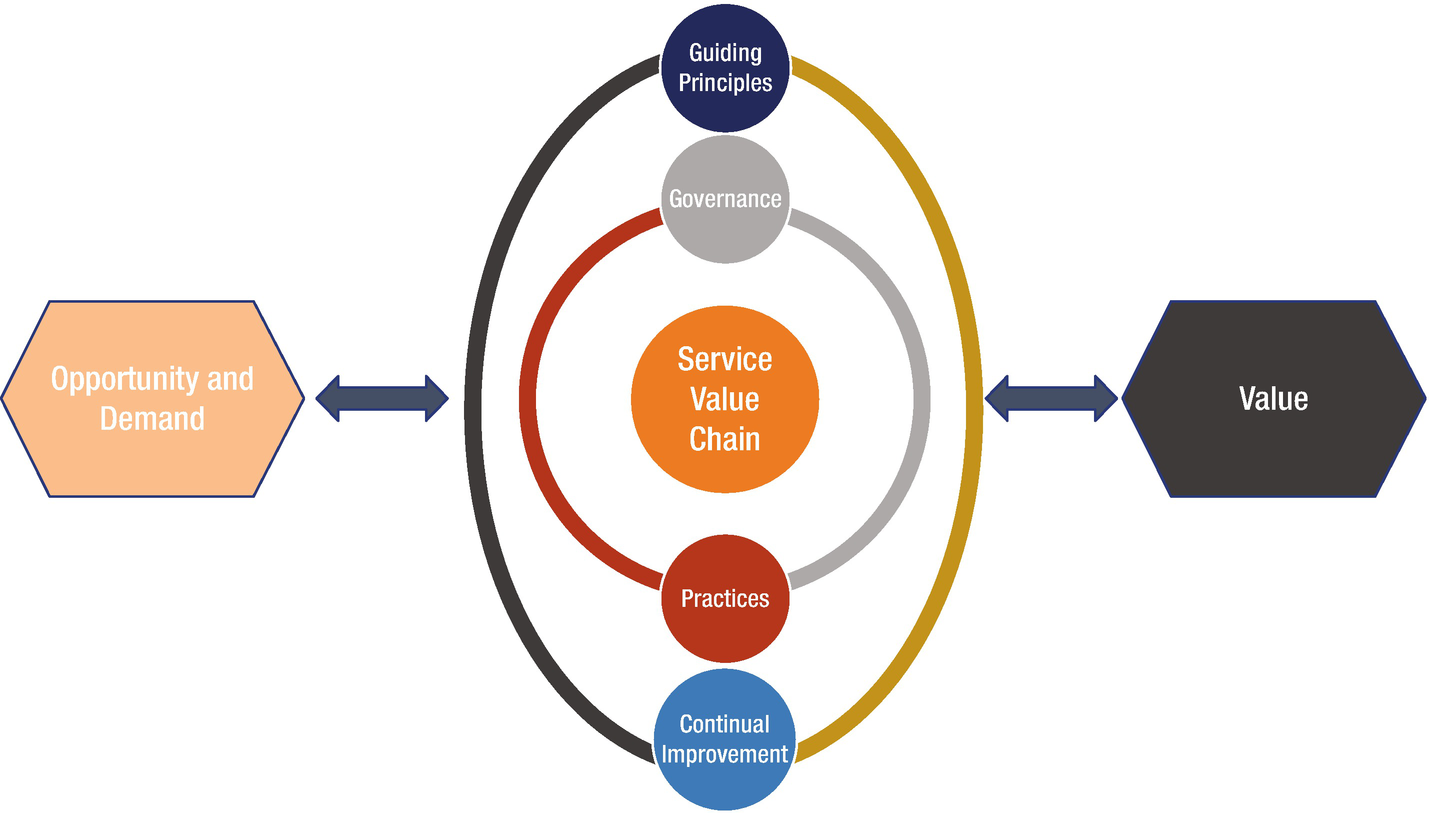
Service value system
It is the various resources and assets within an organization that tie these discrete components together. Remember that an organization will contain various silos. By using various permutations and combinations of these organizational resources, we can generate value; this is possible through some tight coordination and integration.
It is also true that not all organizations are the same. You have some traditional organizations that can be rigid regarding the flexibility with which they can be manipulated to achieve value. And then there are the startups that change like a chameleon. The bottom line is that the organization’s culture, flexibility, and adaptability will set the tone for creating value.
The components of the SVS are discussed in detail later in this chapter except for guiding principles in Chapter 6; continual improvement, which is explained in Chapter 10; and practices in Chapters 7 through 14. We have already discussed value in Chapter 3.
Alternately, you can define service value system as a set of things working together as parts of a mechanism or an interconnecting network to create value through products and services.
Opportunity and Demand
Any business that is undertaken is done so on the back of available opportunities. Without identifying them, going into business is like shooting oneself in the foot. Think about your neighborhood restaurant. Do you think they started the restaurant without doing some research on their potential customers, their competition, and other possibilities? The opportunities give rise to businesses and this is also true with products and services.
ITIL Definition of Opportunity
Opportunity represents options or possibilities to add value for stakeholders or otherwise improve the organization.
ITIL’s definition of an opportunity looks from the perspective of creating value through products and services. Opportunities are not limited to creating and maintaining a new product or a service, but could also be for improving a service or any other aspect of an organization that can lead to a rise in value.
While service providers offer services, they get into a position where they can read the pulse of a customer and can sense other opportunities. These opportunities could be extending the existing services to newer areas or offering adjacent services, or enabling service add-ons that can offer further value to customers.
An aspect that goes hand in hand with opportunity or supplements it is the demand. An opportunity could open up for a service provider to offer products and services. However, without demand for it, it’s doomed to fail. So when an opportunity is identified, the corresponding demand is identified, which is revealed during the market research and study that are undertaken.
ITIL Definition of Demand
Demand represents the need or desire for products and services from internal and external customers.
Understanding demand for products and services is essential. Companies must ensure that they find out the true need and, with the knowledge of opportunities available, offer products and services that are fit for purpose and fit for use (value).
Internal customers are from the same organization as the service provider. External customers are outside of it. The difference between internal and external customers is merely measured in terms of finances. External customers pay real money, and hence their importance is at a high. Internal customers, on the other hand, are an obligation, something that organization must tend to and cannot live without.
The internal IT team charges the internal business units notionally. No real money gets transferred between the business units and the IT team but is noted only in the ledgers. It is like taking money out of your left pocket and depositing it into your right pocket.
Governance
The governance is an integral part of the SVS and it is at the core, meaning it processes the opportunities and demands coming through and has a major say in the value that is getting delivered. So, let us understand what governance is all about.
Although governance is part of the service value system, it is not in the scope of the ITIL Foundation examination. I still encourage you to read this section, as it is practical and matters in work. If you are short of time, skip this section for now and return to it at your leisure.
Governance is about providing direction to an organization, a project, or a country. Governments provide the necessary direction through legislations for countries. At an organization level, we have governance bodies that are set up to provide direction in the definition and enforcement of policies. In projects, governance bodies include key representatives from the customer, service provider, and suppliers, along with sponsors and others who are accountable for the outcome. Products and services too are created similar to projects or on the back of them, and have a governance body to provide direction.
Governance is part of the SVS through the processes and activities for managing services. This governance should conform to organization level governance, which is the primary governance body to ensure evaluation, direction, and monitoring of various activities. Every product or service will have a governance body that is set up to ensure that value is being created and delivered to the customer. The directions put forth by the service/product governance will be based on the organizational principles and policies. The governing body will have a high-level view of all activities that create value and those that are overheads; and more importantly, the ambit of continuous improvement comes under governance as well .
Service Value Chain
The service value chain (SVC) is at the core of the service value system (SVS). The SVS (Figure 5-1) is essential for taking in demands and converting them into value for the customer through products and services. To generate this value, the critical engine that puts things into motion is the SVC.
On the topic of the service value chain, you can expect to get at least one question (equivalent to one mark) on your ITIL foundation exam. The question will test your understanding of the service value chain and your ability to use that understanding to answer the question.
- 1.
Plan
- 2.
Engage
- 3.
Improve
- 4.
Obtain/Build
- 5.
Design and Transition
- 6.
Deliver and Support
The inputs for these activities come through the opportunities and demands, and a combination of these activities is invoked to generate value. Although I have listed the activities in a numbered fashion, it does not mean that the activities flow in a sequential manner. In ITIL V3, we have seen the flow starting with service strategy to service design, service transition, service operations, and continual service improvement. In the SVC, any of the activities can be invoked at any time and they are all interconnected.
Any requirement/demand that involves a planning exercise would be carried out by the plan activity. Whenever third parties are involved, the engage activity jumps in. Likewise, every activity has its own scope and will be called upon as and when needed. These activities work together to generate the required outcomes and create value.
Generating value for a customer is done through value streams, which are a series of activities that intake demands and create value. Every value stream will have a combination of activities and can call on any of the 34 ITIL practices to jump in, play their role, and through teamwork of activities and practices and outcomes, generate value. This could be done through drawing on a combination of internal resources, external resources, ITIL practices, skills, and competencies.
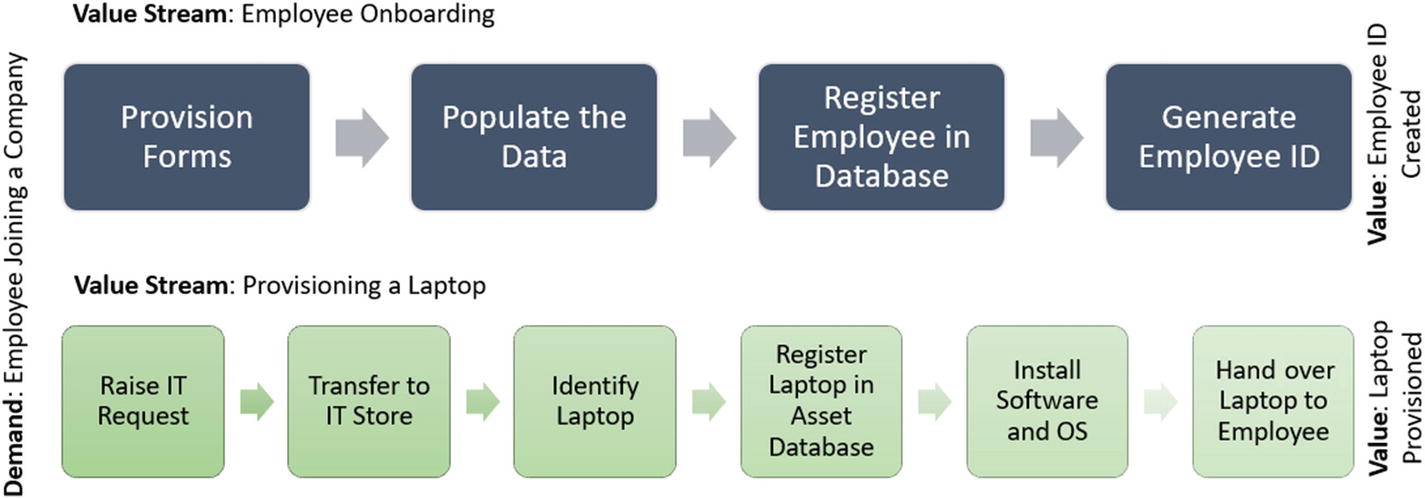
Service value stream illustration
There are two value streams that have been illustrated for the scenario where a new employee joins an organization.
The first value stream is registering the employee (employee onboarding) into the enterprise database, along with filling out various forms and signing nondisclosure agreements and other necessary documents. In this value stream, the first activity would be to provide the forms for the employee to fill out; second is to validate if everything is alright; and finally, accept the changes and generate employee number. The outcome is the employee ID that gets generated at the end of the process. This is value for both the employee and the organization.
The second value stream is provisioning a laptop for the newly joined employee. An IT request is raised for a new laptop, the IT store picks up the request and identifies a laptop from the store, they register the asset in the asset database, and hand over the laptop to the technical team to install the necessary operating system and the software. Once all the installations are complete, the laptop is handed over to the user. The outcome is provisioning a laptop to the employee, which needless to say is value being created for both the employee and the organization.
Each of these value streams works through a combination of activities: the input being the demand (employee joining a company) and the outcomes/value being created at the end of the value stream. To generalize, the SVS calls upon activities to create value based on the demand and the SVC is at the center of the SVS in the value creation process.
The next sections explore each of the six SVC activities.
While understanding the service value chain can fetch you 1 mark on the exam, the six activities associated with the service value chain will get you another mark. You can expect one question based on the six activities listed (as follows) on your ITIL foundation exam. The question will test your understanding and your ability to use the understanding in answering the question.
Plan
The plan activity in the SVC represents the phase or set of activities concerned with identifying strategies for the service provider organization and to make plans accordingly. If you are familiar with ITIL V3, this activity is like the Service Strategy phase. The major difference is the waterfall model in V3 and a parallel approach in ITIL 4. You can call on any of the activities at any juncture, and it need not flow like it did earlier, starting with the strategy phase.
The plan activity exists to ensure that all parties involved in the value co-creation share a common vision (or mutually agreeable ones) and agree on a road map with a good understanding of the status and future steps. This is not only applicable to new products and services alone but also to the improvement initiatives. The planning activity is not restricted to the value stream alone but also stretches to four dimensions, services, and products.
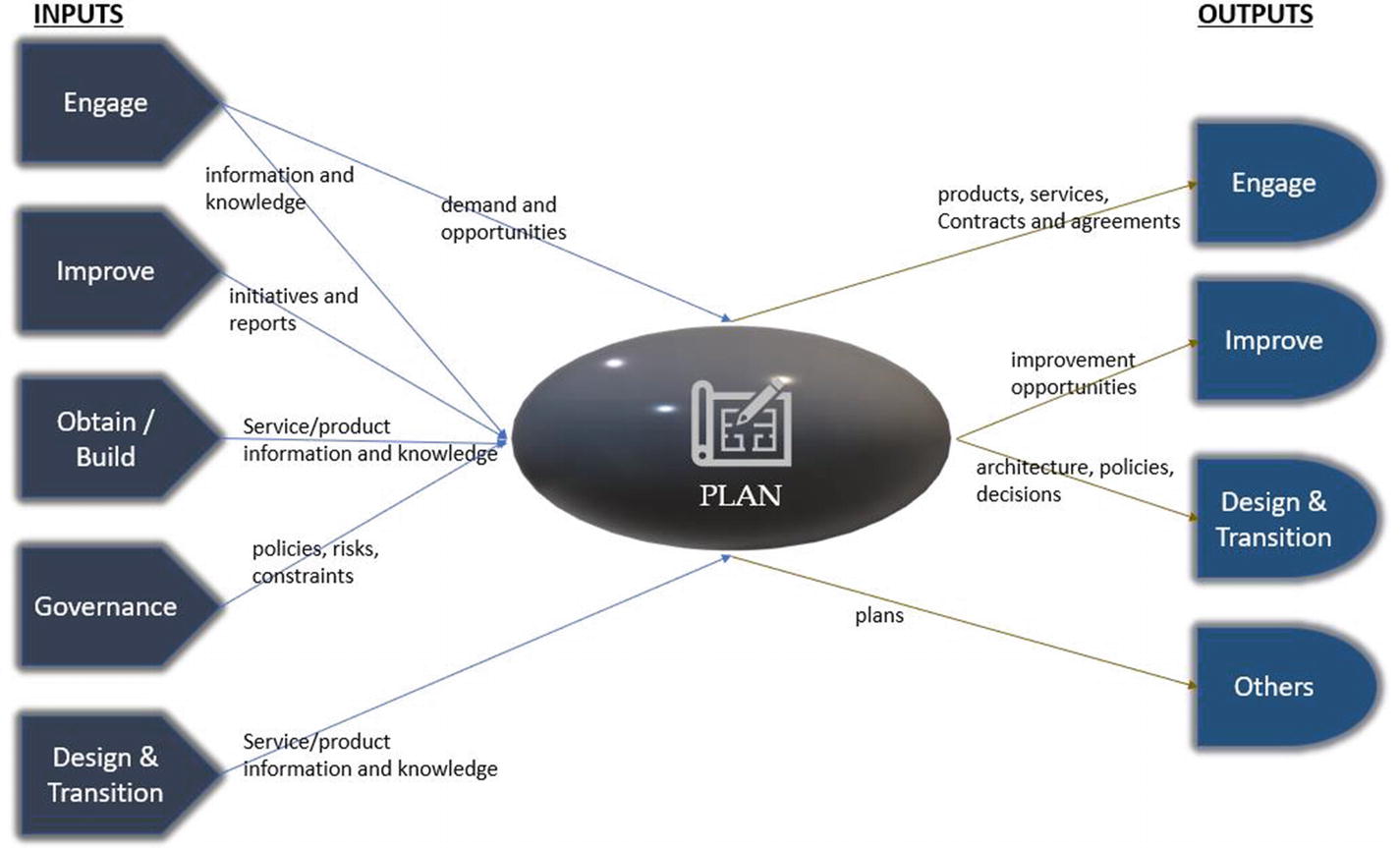
Plan activity inputs and outputs under service value chain
Typical Inputs for Plan
If you are in the business of drawing up strategies, you know that information around the customer demand, the opportunities that are available, the competition, and other market related information are most needed. These will come from the Engage activity from within the SVC. Remember that the Engage activity deals with all external parties for the service provider.
The identified improvement opportunities along with the status of improvements in pipeline and the current performance levels will help in making plans for the existing products and services. This will come from the Improve activity within the SVC.
The various changes that are done to the product/service (through change requests) are fed back to the Plan activity by the Obtain/Build and Design and Transition activities from within the SVC.
The governance layer of the SVS draws up the boundaries through the applicable policies to be considered and identifies the requirements, risks, and constraints that are in play.
Typical Outputs for Plan
The primary output for the plan activity will be to create and propose various strategic, tactical, and operational plans for the organization.
Based on the identified strategies and plans, the activity provides the architectural decisions, portfolio decisions, and policies that are put forth from the strategic perspective to the Design and Transition activity.
Further, the Engage activity gets the information and details around the services and products and the various contracts and agreements that need to be signed between third parties and the service provider organization.
The feedback loop works in a cyclical way with the Improve activity. The plan activity, based on its knowledge and overview, can identify improvement initiatives as well.
Engage
The activity in the SVC that deals with third parties, both within and outside the organization, is the Engage activity . The activity is entrusted with understanding the needs of not only the customers but also all involved stakeholders, and with maintaining a healthy relationship with them.
In the erstwhile ITIL, we did not have a phase per se, but this activity was carried out by the business relationship management and service level management processes.

Engage activity inputs and outputs under service value chain
In a world that is highly interconnected, this activity plays the role of a fulcrum to ensure that all stakeholders stay harmonious in relationship to the common vision and goals set forth. It must as well ensure that the pulse of stakeholders, be it customers or a regulation body, is monitored from time to time.
Typical Inputs for Engage
You can see in Figure 5-5 that the Engage activity has several inputs, which is expected in an industry that relies on several other third parties to provide enabling and supporting services.
The most critical input comes from customers in the form of feedback for the products and services rendered. Customers can be both internal and external. The skill is not just accepting the feedback but to discern it. Every feedback must be responded to on merit, and the activity must ensure that appropriate actions are taken. You will also find in the figure an output going into Improve activity. This is on the back of stakeholder feedback. Other inputs that can be expected from customers could be changes in the demand, change of requirements (or detailing out the high-level requirements), and avenues for new opportunities. At an operational stage, customers engage with the service provider through incidents and service requests as well. Each of these must be prioritized and treated with utmost care. Ideally, there should be a practice for every request that gets to the Engage activity in the SVC.
Apart from customers, suppliers, the state, the legal system, and other stakeholders need managing as well. They might reach out to communicate changes in regulation, exploration for partnership, for coming to an agreement, or they could just be sharing information and knowledge about their products and services.
The Deliver and Support activity provides regular inputs regarding the performance of the services. This is the role that the service level management process in ITIL V3 used to play. Based on the performance, the Engage activity is expected to present the performance to customers and other stakeholders, which is indicated as an output in Figure 5-5.
Further, the Improve activity provides information around the various improvement initiatives that are being undertaken in the organization along with the stage of development and timelines.
Obtain/Build and Design and Transition activities provide information and knowledge around the services and products. This is necessary to keep the activity abreast of the product and service changes.
Under the Plan activity, we looked at the output to the Engage activity, which is shown as an input.
Typical Outputs for Engage
Apart from relaying the feedback from stakeholders to the Improve activity, there could be opportunities identified for improvement in services and products that are passed on as well.
New demands and opportunities coming from stakeholders need to be put through the cycle of strategizing and planning, and this is done as an output to the Plan activity.
The inputs received from operational stages are fed as an output to the Deliver and Support activity after processing it with the set standard operating procedures.
Any requirements to build a new system or developmental inputs are fed to the Obtain/Build activity. To go with this, changes to contracts and agreements need to be sent out to this activity along with the Design and Transition activity, which is entrusted with the information surrounding product and service requirements. The Design and Transition activity uses this information to come up with the architectural designs, implementation plans, and deployments.
In the spirit of visibility and transparency, the Engage activity shares information around third parties, their services and products, and the knowledge gathered across the value stream.
Improve
The Improve activity in the SVC exists to effect continual improvement across the value streams, four dimensions, products, services, and all other service management areas.
The Improve activity in ITIL V3 was the Continual Service Improvement phase, which stretched across the other four phases.
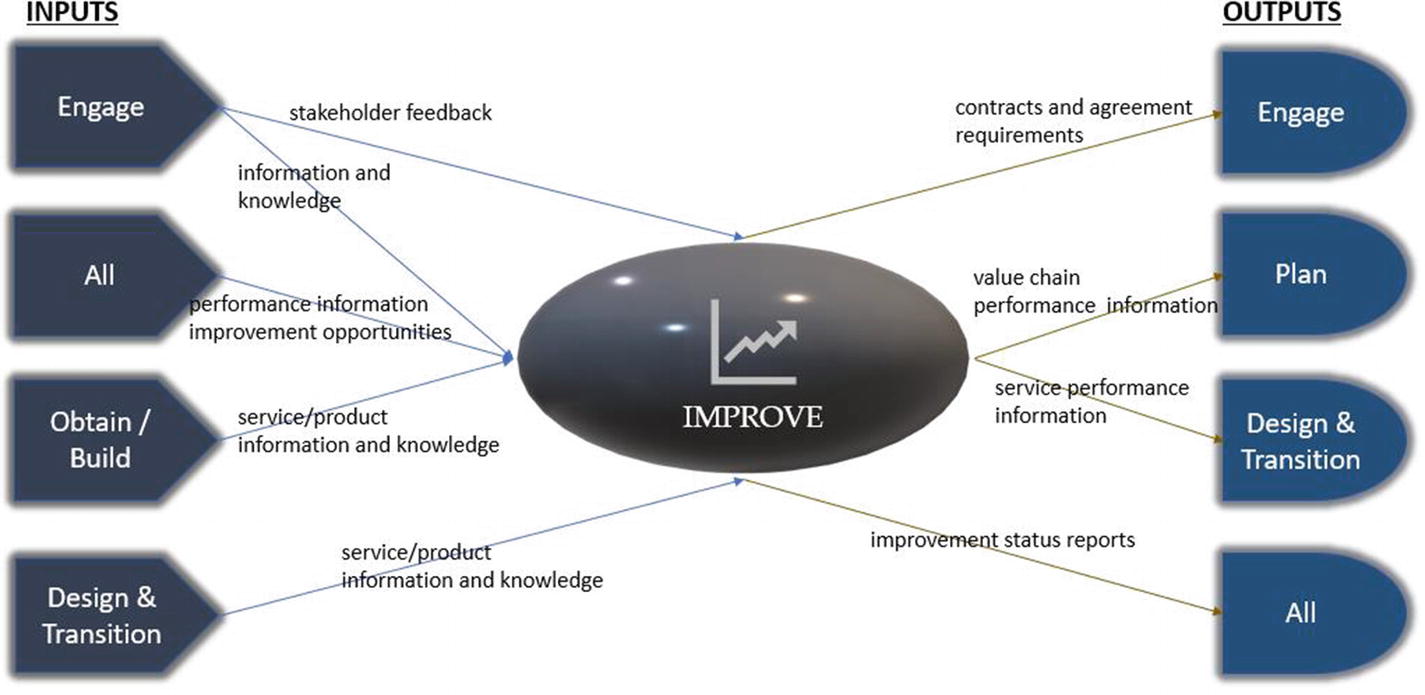
Improve activity inputs and outputs under service value chain
Typical Inputs for Improve
One of the key responsibilities for the Improve activity is to ensure that all parts of service management are on an improvement trajectory. To process and bring about improvements, the Improve activity is fed with various improvement opportunities that are identified across the system and also with the product/service performance information. This information is used as a baseline and as a measurement factor to bring about and prove the improvements that are brought about in the system.
To effectively improve the service or a product, the Improve activity requires inputs from customers and other stakeholders, which it gets from the Engage activity, along with the knowledge around third-party services and their associated components.
Obtain/Build and Design and Transition activities provide information and knowledge around the services and products. This is necessary to keep the activity abreast of product and service changes.
Typical Outputs for Improve
Typically, the Improve activity is expected to report on the improvement initiatives across the streams and parts of the organizations.
The Plan activity is particularly interested in understanding the various activities’ performance in the SVC. This is measured and delivered to the Plan activity.
Based on the improvements in the systems, if there are any changes that are to be expected in services and products, then the related agreements and contracts too need a change. This information is fed to the Engage activity.
The performance information surrounding the services is provided to Design and Transition, as they have a stake in this information to alter the architecture and designs accordingly.
Design and Transition
Design and Transition is the next activity in the SVC . Its main purpose is to ensure that the designs and the transition road maps are in line with the overall plans set forth. From an activity perspective, it exists to ensure that the products and services are designed and transitioned to meet the customer requirements in terms of quality, costs, and time to market.
This activity is similar to the service design phase in ITIL V3 that was responsible for the overall design of a service. There are some parts of the service transition phase that have been embedded in the Design and Transition activity.
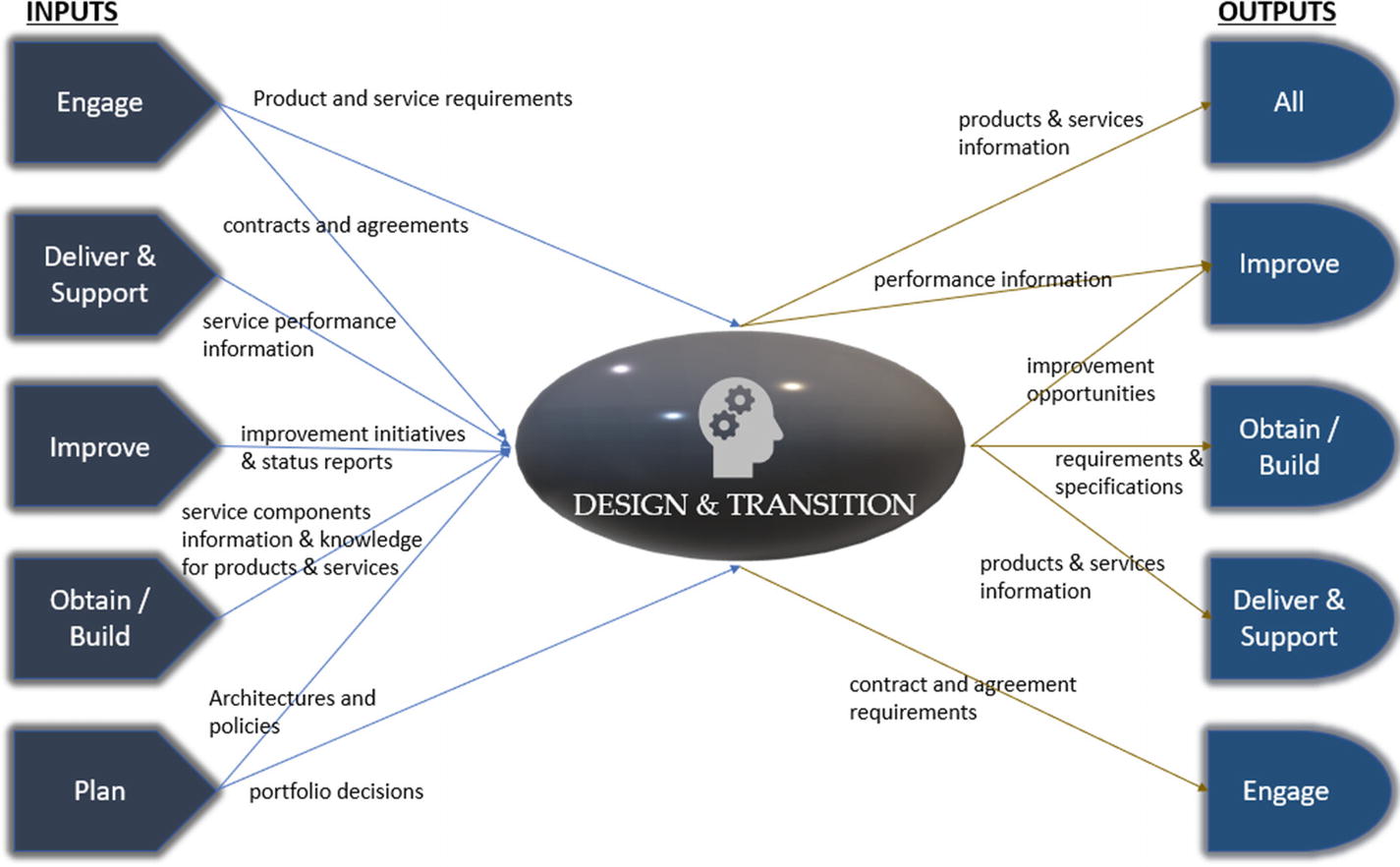
Design and transition activity inputs and outputs under service value chain
Typical Inputs for Design and Transition
Designs are typically drawn when the requirements are in place. These requirements come to the Design and Transition activity through the Engage activity. Apart from this, the contracts and agreements from suppliers and partners who support and enable the product and service creation are also fed through the Engage activity.
The designs are drawn within the boundaries set by the Plan activity—read as the strategic boundaries. This includes the list of products and service portfolios that have been agreed in the Plan activity, and the corresponding architectures and enterprise policies that are relevant during design and transition planning.
The Improve activity feeds information around the various improvement initiatives that are active, along with the results of the earlier performance initiatives. The purpose of feeding these to Design and Transition is to meet the objectives of these initiatives through improved designs. The performance information after applying improvements is fed back to the Improve activity along with other identified improvement opportunities.
The performance of services from the operations (Deliver and Support) and also from improvement initiatives is an input to the activity, as this data is used as a baseline for bettering the designs. This also acts as a feedback for the Design and Transition activity, as it measures up to the service level targets that have been set.
Understanding of the existing service components is obtained through Obtain/Build. This information will typically help in reusing, optimizing, and scaling up as needed. The Obtain/Build activity also provides information around products and services and the changes that they have been through. It could include specifications, known errors, and other operational data. This information is pertinent to enable effective design decisions.
Typical Outputs for Design and Transition
Design and Transition is an activity that plays a crucial role across the SVC. It is one of the main sources of information pertaining to products and services. Say, for example, the Plan activity needs this information because it can potentially influence the existing and future strategies and road maps. Obtain/Build would need this information to develop the product or a service. It needs to be passed on to Deliver and Support, as this is pertinent information for supporting the product or the service.
The Engage activity acts as a conduit for the contracts and agreements that are identified from a design perspective. It could be contracting with a new vendor for an identified design or partnering up with an automation company to meet certain goals.
The various improvement opportunities along with the performance information identified by the Design and Transition activity are fed to the Improve activity for managing the improvement initiatives to closure. The shortcomings identified in this activity are fed to the Improve activity in anticipation of finding a permanent solution for them.
As we build new products and services, the identified requirements and specifications from a design and transition perspective are inputted to the Obtain/Build activity. This data will be used by the Obtain/Build activity to procure components such as servers, software licenses, and resources, among others.
Obtain/Build
Obtain/Build is the next value chain activity, which deals with mobilizing the right kind of resources that are needed to deliver value to customers through products and services, and to develop products and services. It is an activity that is entrusted with ensuring that all necessary service components that fit the bill are made available before the service delivery can begin delivering value. For example, service components such as infrastructure, people, software licenses, and automation, among others, may be necessary for developing a product or a service. Ensuring that these resources are in place is one of the jobs of the Obtain/Build activity. Once these are in place, the next objective is to build it before the next value chain activity—Deliver and Support—can take over.
Securing and procuring resources is new to the ITIL framework. The focus thus far has been on identifying the different types of assets and resources that were needed to run a service successfully. How these resources would be obtained was primarily kept outside the scope. It was expected that procurement and human resource processes would step in and deliver. With ITIL 4, these activities have been formalized. The activity around development of services was carried out by the service transition phase.
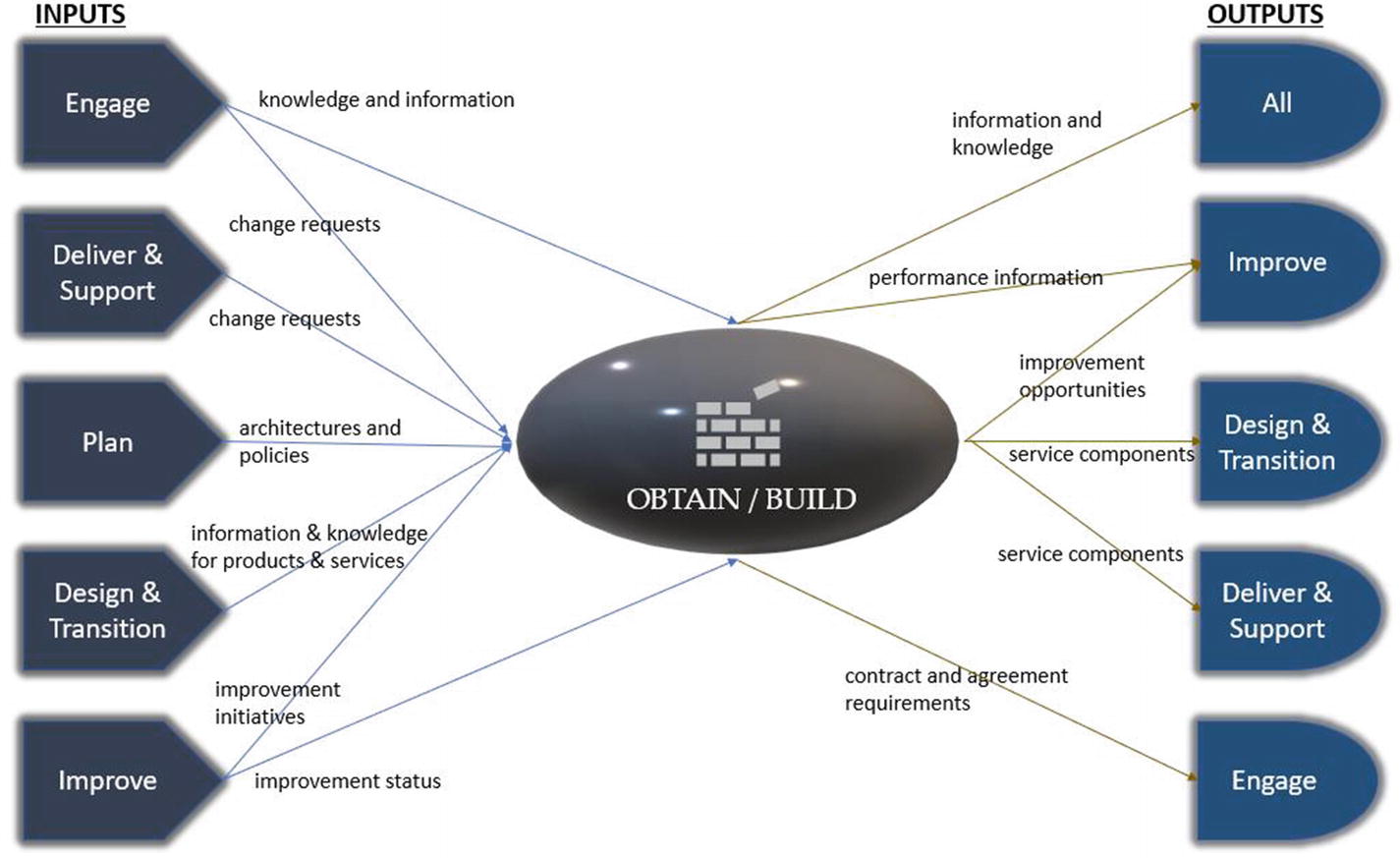
Obtain/Build activity inputs and outputs under service value chain
Typical Inputs for Obtain/Build
In other value chain activities, we have seen that the output of Plan—architectures and policies—is consumed by other value chain activities. Obtain/Build also consumes it, as the information is used in obtaining and building as per the specifications.
Requirements and specifications come from the Design and Transition activity. This is essentially the designs that have been developed by the activity. This information is used by the Obtain/Build activity to procure and mobilize resources. After the resources have been mobilized, products and services are developed based on the designs.
Knowledge and information of new or changed services is an input that comes through from Design and Transition activity. Any new services or changes to the existing one require new resources to develop and deliver them.
The Engage activity feeds in contracts and agreements to the Obtain/Build activity, which provides the parameters for the activity to conduct its business based on the available third parties. Goods and services are delivered by both the internal and external suppliers and through partnerships. The contract in place will be binding for the goods and services to be supplied. The Engage activity is responsible for maintaining the relationship through which the information and necessary resources flow, and Obtain/Build activity is responsible for ensuring receiving of the goods and services based on the specifications put forth. The Engage activity also provides change requests and project initiation requests as an input to Obtain/Build. Change requests or project initiation requests are normally put in through customer requests, and Obtain/Build activity’s support is essential to deliver the change or a project.
In the SVC, Obtain/Build activity can expect to get change requests from Deliver and Support activity as well. Based on the change requests, changes are needed to be done that require additional resources/people, and a project team may be needed to do the actual development before the end product is fed back to the Deliver and Support activity. Example: If a transition of an operating system is identified, let’ say a project team is involved to deliver it. The project team operates in the Obtain/Build activity. To carry out this activity, which is a result of a change request, people with the right skill sets need to be hired, infrastructure needs to be provisioned for the new operating system, and the operating system licenses need procuring as well. Once the resources are in place, the operating system upgrades are carried out and tested. When satisfied, the finished product is handed to Delivery and Support for maintenance and operational work.
The Improve activity is interested in bettering products and services. From its perspective, the improvement initiatives and statuses are provided to Obtain/Build to materialize the identified improvement initiatives.
Typical Outputs for Obtain/Build
From the Obtain/Build activity, we should expect to see outputs that are typically services, products, modified services, modified products, and various individual components that make up these products and services.
The service components, which include all the knowledge about the service, are fed to the Design and Transition activity to enable a smooth transition into Deliver and Support activity. Staying with the same example as earlier, after the operating system upgrades are done, the finished product is handed to Design and Transition to plan and deploy it into production. After the deployment, the responsibilities to manage the services and the service components lie with Deliver and Support. In a related example, if the Obtain/Build activity was to procure and configure a switch, and if it can be replaced without the aid of a full blown transition plan, it gets delivered directly to the Deliver and Support activity.
Staying with service components, the knowledge and information about these services are consumed by all other SVC activities and are a primary output of the Obtain/Build activity. If anything is modified or built anew, every activity needs to know how to carry out their respective responsibilities such as Engage for engaging third parties when the contracts need changing, to the Improve activity for setting a new baseline.
Deliver and Support
The Deliver and Support activity pertains to operations and maintenance of services. The purpose is to maintain the service status quo and to ensure that the services deliver as per the specifications and designs that are put in place. Importantly, all stakeholders must be able to obtain value and meet their expectations.
Let us further explore two terms that are used here: deliver and support. Deliver pertains to the service that is delivered, the capability that is extended to users and customers. Support comes into play when the service does not function as expected, or when changes (service requests) are requested that enhance the service experience.
Deliver and Support hires a majority of people in the IT industry. For every person in development, you can expect eight to ten people hired in the operations area. This is due to the perpetuity nature of operations. While projects have a limited time period, operations run as long as the products and services are supported. However, in DevOps, the lines become blurred and the gulf between the two is reduced somewhat, because you tend to have a continuous development lifecycle and share resources between both development and operational activities.
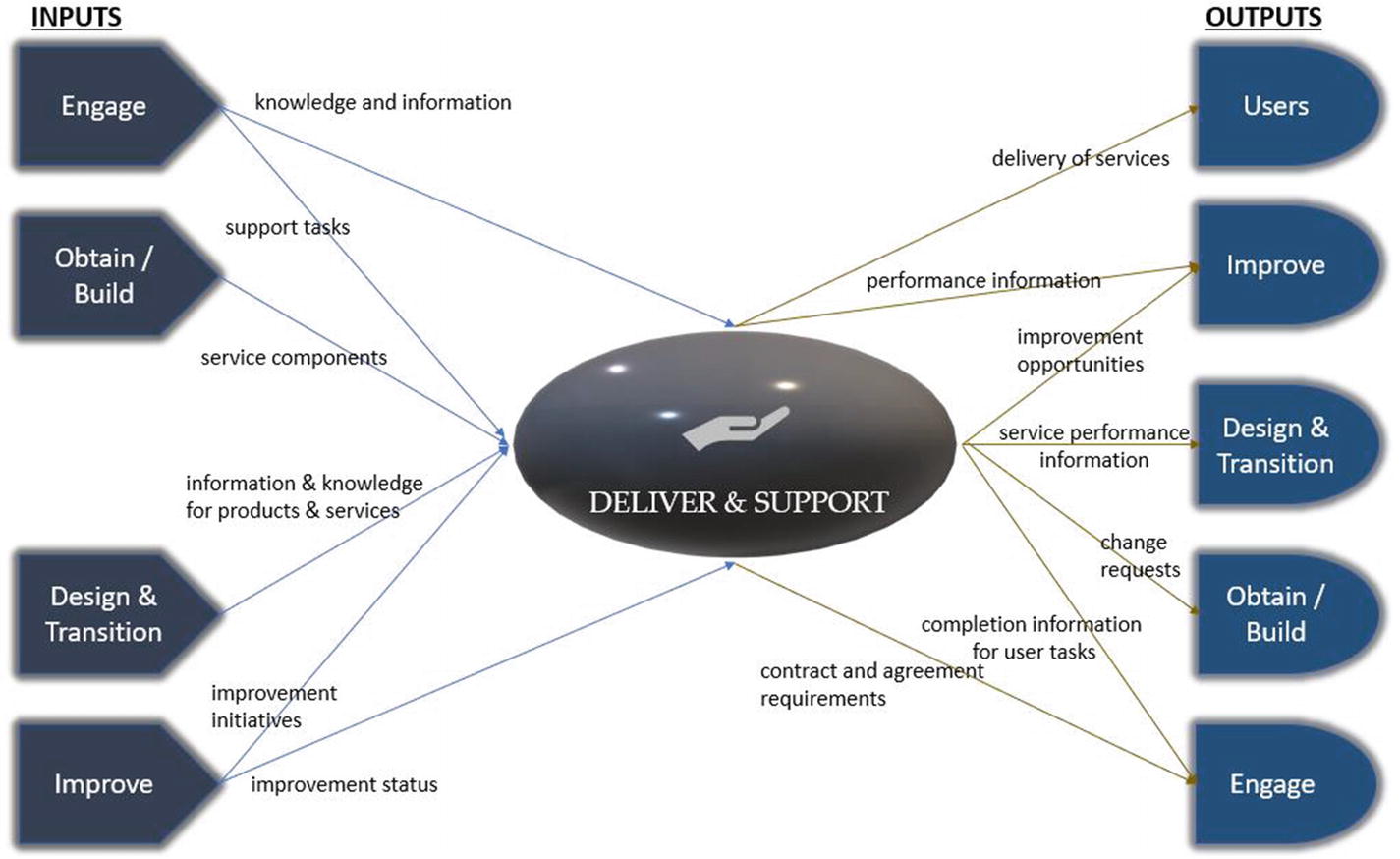
Deliver and Support activity inputs and outputs under service value chain
Typical Inputs for Deliver and Support
Deliver and Support is an activity that ensures that services are maintained and any anomalies are duly taken care of. The inputs to this activity therefore will mainly come from the user community in the form of incidents and service requests. These service requests get to the Deliver and Support activity through the Engage activity. Remember that users talk to Deliver and Support through the Engage activity.
Apart from the support requests, the various contracts and agreements and knowledge and information around third-party components are fed through the Engage activity. This information is vital to upkeep of services.
In the Obtain/Build activity we looked at how the flow of services that are built gets transitioned through the Design and Transition activity. The input that comes through the Design and Transition activity is the information and knowledge about products and services that have been transitioned—the information that is necessary to keep the services in status quo and the knowledge to perform break-fix activities. The Obtain/Build activity also feeds in the information around service components, which helps in providing support to end users.
Improvement initiatives, plans, and statuses of ongoing improvement activities come through the Improve activity.
Typical Outputs for Deliver and Support
The longest and continuously running activity, Deliver and Support, acts as an input system to multiple activities within the value chain and to the users.
The services that are delivered and the support that is extended through incidents and service requests are the primary outputs to customers and the user community. While you support users, the Engage activity, which provides the inputs to support users, needs to be informed of its progress. Say for example that a user raises an incident stating that the printer in the bay is not working. The Deliver and Support activity resolves the printer problem and sends out a notification through the Engage activity to the user that the printer is now working.
Further, any changes needed to the contracts and agreements go back to the Engage activity as well.
Apart from the support task statuses, the Engage activity will also receive performance information that indicates the service levels that have been agreed for the service. This information is fed to the Improve activity as well, which acts as an input to identify improvement initiatives.
The Deliver and Support activity too contributes to improvements by identifying improvement opportunities and inputting this information to the Improve activity to take further action. Generally, this would work in two ways. First, surveys are sent out to customers and users seeking their feedback on the service and support. These inputs could be collated and analyzed to identify improvement opportunities. Second, the IT staff working in Deliver and Support knows the services like the back of their hand because they deal with them quite closely and find themselves in a position to identify opportunities for improvements. All these improvement tips are like gold dust to any service provider.
The Design and Transition activity requires feedback on their designs and transitions that have been put in place. This feedback comes in the form of service performance information from Deliver and Support. Examples of service performance information include availability reports, capacity reports, and network bandwidth reports.
Changes to services are quite common during operations. They could come in the form of replacing and reconfiguring infrastructure or making changes to the network or software. Such activities are handled by Obtain/Build, and this information comes through the Deliver and Support activity.
Knowledge Check
- 5-1.Which of the following does not figure in the service value system components?
- A.
Guiding Principles
- B.
Four Dimensions
- C.
Practices
- D.
Continual Improvement
- A.
- 5-2.Which of the following accurately represent the definition of opportunities?
- A.
Represents options or possibilities to add value for stakeholders or otherwise improve the organization
- B.
Provides demand information for creation of value to the service value system
- C.
Provides the option to add resources and assets to meet the demand coming through from sponsors
- D.
Represents the various value options that can be presented to the customer in order that it can be co-created
- A.
- 5-3.Which of the following activities deals with stakeholders?
- A.
Engage
- B.
Deliver and Support
- C.
Customer Relationship Management
- D.
Business Relationship Management
- A.
- 5-4.The primary function of Obtain/Build is:
- A.
Obtain resources and build plans
- B.
Develop project plans and implement it
- C.
Secure resources and develop services
- D.
Secure products and build services
- A.
- 5-5.Which of the following is not an output for the Deliver and Support activity?
- A.
Obtain/Build
- B.
Users
- C.
Plan
- D.
Design and Transition
- A.
